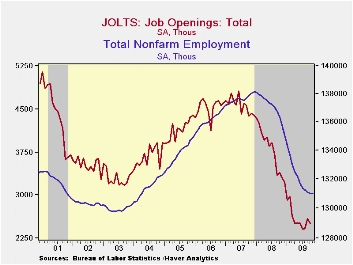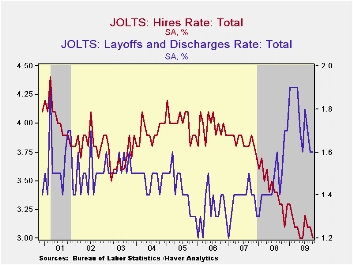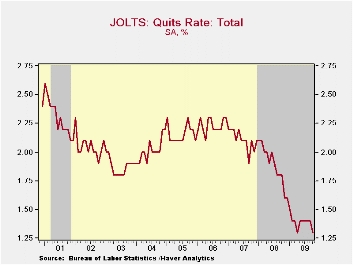 Global| Dec 09 2009
Global| Dec 09 2009JOLTS: U.S. Job Openings and Hiring Falls
by:Tom Moeller
|in:Economy in Brief
Summary
The labor market remains soft. The Bureau of Labor Statistics reported in its Job Openings & Labor Turnover Survey (JOLTS) that job availability during October gave back half of the September increase with a 3.1% decline. Openings [...]
 The labor
market remains soft. The Bureau of Labor Statistics reported
in its Job Openings & Labor Turnover Survey (JOLTS) that job
availability during October gave back half of the September increase
with a 3.1% decline. Openings were off 26.1% from October of last year.
The series dates back to December 2000.
The labor
market remains soft. The Bureau of Labor Statistics reported
in its Job Openings & Labor Turnover Survey (JOLTS) that job
availability during October gave back half of the September increase
with a 3.1% decline. Openings were off 26.1% from October of last year.
The series dates back to December 2000.
The job openings rate held steady m/m at 1.9%. These rates were down from more than 3.0% in 2007. The job openings rate is the number of job openings on the last business day of the month as a percent of total employment plus job openings.
Factory
sector job openings rose for the third consecutive month but they remained down 41.3% y/y. Construction
sector job openings gave back all of their September increase and were
down 27.8% y/y. Nevertheless, openings here were nearly double the
series low reached in April. The
level of professional & business services job openings gave
back half of the September increase (-23.1% y/y) while education
& health sector job openings (-17.6% y/y) also reversed half
the prior month's gain. Openings in retail trade rose slightly m/m
(-24.2% y/y) and remained up sharply from the April low while
government sector job openings rose m/m from slightly from the series
low (-23.4% y/y).
The JOLTS survey dates only to December 2000 but has
followed the movement in nonfarm payrolls, though the actual
correlation between the two series is low. A description of the Jolts
survey and the latest release from the U.S. Department of Labor is
available here
. and the figures are available in Haver's USECON
database.  The hires
rate
dipped m/m to 3.0% and returned to the series record low. The
hires rate is the number of hires during the month divided by
employment. The actual number of hires also fell
2.3% m/m and was down 11.6% year-to-year. Factory sector hiring
recently gave back most of its September increase and was off 13.4% y/y
while construction sector hiring also dipped m/m (-10.0% y/y). Leisure
& hospitality industry jobs fell 1.3% to a new series low
(-16.0% y/y) and retail sector hiring (-15.5% y/y) remained quite weak.
In the professional & business services industry, hires fell
2.1% (-10.0% y/y) after three months of increase. In the education
& health services industries, past jobs figures were revised
sharply and in October they fell moderately, down 5.9% y/y.
The hires
rate
dipped m/m to 3.0% and returned to the series record low. The
hires rate is the number of hires during the month divided by
employment. The actual number of hires also fell
2.3% m/m and was down 11.6% year-to-year. Factory sector hiring
recently gave back most of its September increase and was off 13.4% y/y
while construction sector hiring also dipped m/m (-10.0% y/y). Leisure
& hospitality industry jobs fell 1.3% to a new series low
(-16.0% y/y) and retail sector hiring (-15.5% y/y) remained quite weak.
In the professional & business services industry, hires fell
2.1% (-10.0% y/y) after three months of increase. In the education
& health services industries, past jobs figures were revised
sharply and in October they fell moderately, down 5.9% y/y. The job
separations rate fell to a new series low of 3.2% with the
actual number of separations off 14.4% year-to-year.
Separations include quits, layoffs, discharges, and other separations
as well as retirements. Layoffs and discharges alone dipped
0.3% (+0.5% y/y) during October but are down 17.4% from the
January peak.
The job
separations rate fell to a new series low of 3.2% with the
actual number of separations off 14.4% year-to-year.
Separations include quits, layoffs, discharges, and other separations
as well as retirements. Layoffs and discharges alone dipped
0.3% (+0.5% y/y) during October but are down 17.4% from the
January peak.
| JOLTS (Job Openings & Labor Turnover Survey) | October | September | August | Oct. '08 | 2008 | 2007 | 2006 |
|---|---|---|---|---|---|---|---|
| Job Openings, Total | |||||||
| Rate (%) | 1.9 | 1.9 | 1.8 | 2.4 | 2.3 | 3.1 | 3.3 |
| Total (000s) | 2,506 | 2,586 | 2,423 | 3,390 | 3,224 | 4,382 | 4,606 |
| Hires, Total | |||||||
| Rate (%) | 3.0 | 3.1 | 3.1 | 3.3 | 41.1 | 46.1 | 47.6 |
| Total (000s) | 3,966 | 4,061 | 4,040 | 4,486 | 56,486 | 63,666 | 64,879 |
Tom Moeller
AuthorMore in Author Profile »Prior to joining Haver Analytics in 2000, Mr. Moeller worked as the Economist at Chancellor Capital Management from 1985 to 1999. There, he developed comprehensive economic forecasts and interpreted economic data for equity and fixed income portfolio managers. Also at Chancellor, Mr. Moeller worked as an equity analyst and was responsible for researching and rating companies in the economically sensitive automobile and housing industries for investment in Chancellor’s equity portfolio. Prior to joining Chancellor, Mr. Moeller was an Economist at Citibank from 1979 to 1984. He also analyzed pricing behavior in the metals industry for the Council on Wage and Price Stability in Washington, D.C. In 1999, Mr. Moeller received the award for most accurate forecast from the Forecasters' Club of New York. From 1990 to 1992 he was President of the New York Association for Business Economists. Mr. Moeller earned an M.B.A. in Finance from Fordham University, where he graduated in 1987. He holds a Bachelor of Arts in Economics from George Washington University.






